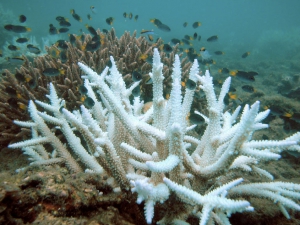Fading Corals: The Effect of Anthropogenic Climate Change on Coral Reefs
By Konnor Payne, SRC intern
Due to the dramatic ecological changes caused by humans to the Earth, a new period has been named after humans called the Anthropocene. In the Anthropocene, it appears, the next change is to the Earth’s coral reefs. The number one cause of stony coral (Reef-building coral) loss is the warming of waters due to anthropogenic global warming (Causey, 2001; Manzello, 2015). As technology and industry continue to accelerate, the issue of global warming will only worsen and thus the coral reefs shall continue to suffer.

Figure 1. The coral is bleached and has had its zooxanthellae expelled. This can occur to any reef-building coral that is under too much stress from outside influences. The coral is starving without the photosynthetic symbiote and is likely to starve to death. (Source: “KeppelBleaching.” Wikipedia.org, 22 Aug. 2011, en.wikipedia.org/wiki/File:Keppelbleaching.jpg)
Corals are tiny soft-bodied organisms related to sea anemones that build a calcium carbonate skeleton around themselves. Within their bodies is a symbiotic dinoflagellate, called zooxanthellae, that photosynthesizes to provide the corals with organic matter. Bleaching is when a coral colony becomes so overly stressed that the zooxanthellae are expelled resulting in a lack of color. In this bleached state, the coral begins to starve and is likely to die. In the Florida Keys Reef Tract (FKRT) increasing sea surface temperature has led to an increase in the number of major bleaching events (Van Hooidonk et al., 2013), leading to the loss of 40% of stony corals since 1996 causing an ecological shift towards octocorals, macroalgae and sponges (Ruzicka et al., 2013).
In May of 2015 and 2016, researchers excavated coral skeletal cores from the two most critical reef-building corals, Siderastrea sidereal and Pseudodiploria strigose, in the FKRT to examine skeletal density, growth and calcification rates. Using X-rays and a 3D modeling program, (Horos V2.0.2) the layers of coral grown each year could be analyzed accurately pixel by pixel. The researchers found that the skeletal density remained consistent up until the last century, in which overall skeletal density significantly decreased, but extension and calcification rates did not change significantly compared to their respective biological history (Rippe, 2018). Both species of coral have been able to sustain baseline growth rates despite recent bleaching events and chronic ocean warming. This suggests that corals of the subtropical environment are likely to have a buffer to the effects of ocean warming and the underlying cause of reduction in the skeletal density is levels of aragonite saturation in the water (Rippe, 2018). The study suggests that further research into the carbonate chemistry of the FKRT is required to understand how heavily aragonite saturation affects skeletal density.

Figure 2. The coral skeletal core has distinctive bands to distinguish skeletal density, extension and calcification rates over the years. By comparing past to future bands, the anthropogenic effects on the coral can be visually determined. (Source: Felis 2005).
Works Cited
Causey, B. (2001). Lessons learned from the intensification of coral bleaching from 1980–2000
in the Florida Keys, USA. Paper presented at the Proceedings of the Workshop on Mitigating Coral Bleaching Impact through MPA Design. Honolulu, Hawaii.
Felis, Thomas. “Paleoclimatology: Climate Close-Up.” NASA Earth Observatory, 23 Dec. 2005, earthobservatory.nasa.gov/Features/Paleoclimatology_CloseUp/paleoclimatology_closeup_2.php.
Manzello, D. P. (2015). Rapid recent warming of coral reefs in the Florida Keys.
Scientific Reports, 5.
Rippe, John. (2018). Corals sustain growth but not skeletal desnity across the Florida Keys Reef
Tract despite ongoing warming. Primary Research Articles.
Ruzicka, R., Colella, M., Porter, J., Morrison, J., Kidney, J., Brinkhuis, V., … Meyers, M.
(2013). Temporal changes in benthic assemblages on Florida Keys reefs 11 years after the 1997/1998 El Niño. Marine Ecology Progress Series, 489, 125-141.
Van Hooidonk, R., Maynard, J., & Planes, S. (2013). Temporary refugia for coral reefs in a
warming world. Nature Climate Change, 3(5), 508-511.



